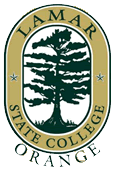Lamar State College–Orange
 |
|
|
Former names
|
Lamar University Center at Orange, Lamar University-Orange |
|---|---|
| Type | State-operated community college |
| Established | 1969 |
| Affiliation | Texas State University System |
| Chancellor | Brian McCall |
| President | J. Michael Shahan |
| Students | 2,318 (Fall 2015) |
| Address |
410 Front St., Orange, Texas, 77630, U.S. 30°5′28.7″N 93°43′56.9″W / 30.091306°N 93.732472°WCoordinates: 30°5′28.7″N 93°43′56.9″W / 30.091306°N 93.732472°W |
| Campus | Urban |
| Colors | Green and Gold |
| Website | www |
 |
|
Lamar State College–Orange is a two-year, state supported institution of higher education located in Orange, Texas. It currently serves approximately 2,300 students. The college offers both academic transfer and vocational/technical curricula. [1] The college is a component institution of the Texas State University System.
Opened in the fall of 1969 as an extension center of Lamar University, LSC-O first held classes in a vacant elementary school (Tilley Elementary) located on the site of the former naval base in Orange. That structure burned in 1971, prompting community leaders to raise funds for the purchase of a new facility that could accommodate students. The fund-raising campaign produced $250,000 that allowed for the purchase of a building located on Front Street in downtown Orange. That same year the Texas legislature approved the operation of a two-year educational center in Orange and appropriated $125,000 to support the operation of the center (known as Lamar University at Orange).
Dr. Joe Ben Welch played a key role in the early growth and development of the college. He served as director, dean, provost, and president during his nineteen-year tenure at the institution. The initial class offerings focused on academic courses that would transfer and count toward a baccalaureate degree. Welch, however, saw the need to offer career-oriented programs that would prepare students for immediate entry into the workforce and began to add programs such as vocational nursing and welding. This mix of academic and career-oriented programs defines the campus mission to this day. The campus attracted more students and enrollment grew to over 800 students by 1979.
During the 1980s, the college gained its own identity and became independent from Lamar University. The Texas legislature created the Lamar University System in 1983 and named Lamar University at Orange as a component of that system. In 1985, Texas voters approved a constitutional amendment establishing a dedicated fund for capital expenditures. Lamar—Orange was included among the institutions eligible to draw upon this fund. The campus applied to the Southern Association of Colleges and Schools for independent accreditation in 1987 and received that accreditation in 1989. The Texas legislature affirmed the college's degree granting authority in 1991.
Following Dr. Welch's departure, the Lamar University System Board of Regents named Steve Maradian as president. He served until 1994 and was successful in bringing external grant funding to the campus. In 1994, the Board selected J. Michael Shahan to succeed Maradian.
...
Wikipedia
